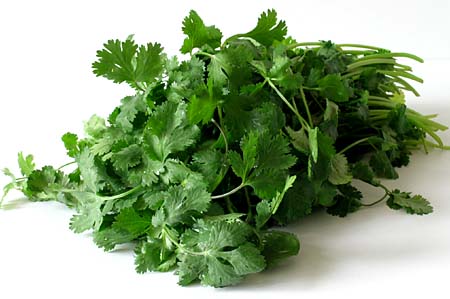
I don’t like cilantro.
I think I’ve made serious progress in not saying I loathe cilantro or I find cilantro disgusting. I’d prefer not to eat it but I’ve learned to tolerate it since it appears in so many dishes I like.
So I found a recent New York Times article headlined “Cilantro haters, it’s not your fault” interesting for two reasons:
First, who doesn’t like having their opinion affirmed? Reading that:
“The authoritative Oxford Companion to Food notes that the word “coriander” is said to derive from the Greek word for bedbug, that cilantro aroma “has been compared with the smell of bug-infested bedclothes” and that “Europeans often have difficulty in overcoming their initial aversion to this smell.”
means I might be in the minority here but I’m not alone.
Second, the article explains why some people might dislike cilantro, and specifically think it doesn’t taste like food.
When we taste a food, the brain searches its memory to find a pattern from past experience that the flavor belongs to. Then it uses that pattern to create a perception of flavor, including an evaluation of its desirability.
If the flavor doesn’t fit a familiar food experience, and instead fits into a pattern that involves chemical cleaning agents and dirt, or crawly insects, then the brain highlights the mismatch and the potential threat to our safety. We react strongly and throw the offending ingredient on the floor where it belongs.
Many people, even those who like it, describe cilantro as having a soapy taste. Understandably this would be offputting for some, but in others, they recognize that taste and still enjoy cilantro. That’s not unlike people who enjoy a wine they’d describe with terms like medicinal, old saddle or wet dog.
Here’s the fit for a blog about evolution: a neuroscientist quoted in the story says we can retrain our brains to have different associations with a flavor.
The first time I encountered cilantro, I thought the Indian food I was eating had picked up the taste of the tin packaging it was in. I tried to eat away from the edges, thinking that’s where the problem started, but couldn’t escape it.
I’ve since tolerated cilantro in guacamole and in Thai soups and though it’s not my favorite, I like those dishes enough to cope. As a result, I think I’m teaching my brain that it’s not tin but instead it’s associated with yummy things.
I blogged a while back about retasting foods I thought I didn’t like. The point of that piece was that tastes can change as we age.
This recent Times article was intriguing to me because it suggests it’s not just trial and error but that we can teach our mouths to like something.
Does that mean I need to mount a reprogramming campaign to develop a taste for oranges, too?
Have you ever learned to like something? Did you do it intentionally?
More on cilantro: Cilantro-phobes (via Indian Culinary Center)
Did you like this post?
Share it on Facebook / Twitter / Digg / StumbleUpon / Reddit / Fark / Del.icio.us

